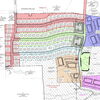Processing Your Payment
Please do not leave this page until complete. This can take a few moments.
Project focused on new food economy aims to create Maine's 59th credit union
 Photo / Tim Greenway
Scott Budde, project director of Maine Harvest Credit Project, left, and Sam May, advisory board chairman, at Broadturn Farm in Scarborough.
Photo / Tim Greenway
Scott Budde, project director of Maine Harvest Credit Project, left, and Sam May, advisory board chairman, at Broadturn Farm in Scarborough.
The Maine Harvest Credit Project, which aims to create a specialized, socially responsible credit union focused on the new food economy in Maine, has raised $1.4 million, or about 60% of the money it needs from donors, to start what would be the state's 59th credit union, the first new credit union in more than 25 years.
It plans in January to file its application to become a state-chartered credit union, Maine's 13th, with Maine's Bureau of Financial Institutions and to get National Credit Union Administration insurance for deposits, says CEO and project director Scott Budde.
“We've met with both institutions several times to prepare to submit the application,” Budde says, adding that both think the application is ready for submission.
The likely location for the credit union is central Maine, where he and advisory board chair Sam May, who co-founded the project with him, already are looking at properties to lease. The credit union will only do business in Maine.
After the application there will be a public comment period, and the two men will set about raising the remaining $1 million from donors, a process they anticipate will take about nine months.
“We can't start until we have $2.4 million,” Budde explains. “We need to be well capitalized to support lending as we'll be doing larger loans than the average credit union.” Regulators typically like to see credit unions start with 7% of their expected equity raised, and Maine Harvest will have 15% if all goes according to plan with donors, he says.
Once Maine Harvest has its credit union charter, it expects to raise seven times the amount of the donated seed money in deposits to provide funds for farm and small business loans.
The donors to date are the Sewall Foundation, the Ram Island Conservation Fund and Sandy River Charitable Foundation, all of which donated over the past year.
If the credit union gets the green light, in eight years Budde expects it to have about $12 million in assets, with some 75% of its business focused on loans to buy farm land, which are hard to come by currently. It also plans to have three employees: Budde as CEO, May as board chairman plus they plan to hire a chief loan officer.
But getting to the point of being able to submit an application was a long stretch involving filling in about 3 inches of paperwork and detailed interviews with 36 farmers as well as the Maine Brewers' Guild, the Maine Cheese Guild and the Maine Grain Alliance for proof-of-concept of the new, focused credit union.
“These were two-to-three-hour interviews,” says Budde. A lot of the discussion was about how difficult it is to get loans for farmland, equipment and expansions. Budde says that's likely because the other financial institutions don't understand the farming business well or don't want to assume the risk of an underperforming farm due to drought or other conditions.
“Community banks and credit unions don't have the in-house expertise to assess the risk profile [of the farm land],” adds May. “They also don't understand how farm diversification, community supported agriculture, farmers markets and [aspects of farming] work.”
Loans with a social mission
To May, who grew up on a mid-coast dairy farm, there's nothing better than the smells of a barn in winter, the spilled milk, the silage and manure all mixed together.
“I have deep relations to farmland and agriculture,” he says. “I'm a homesteader and a vegetable farmer, and I'm on the board of the Maine Organic Farmers and Gardeners Association. He also is on the steering committee of Slow Money Maine.
He watched as his neighbor's dairy farm went under and got turned into a golf course in the tough business conditions of the 1960s, an experience that made him want to help with one of the toughest aspects of farming: financing to buy land.
Budde's ties to agriculture came at investment firm TIAA-CREF, where he created the firm's first investment department focused on social and impact investing strategies.
Maine Harvest is now under the auspices of Maine Farmland Trust and MOFGA. The project also is under the fiscal sponsorship of MOFGA, which provides it with 501(c)3 status and handles the project's receipts, disbursements and fund-tracking.
If granted credit union status by regulators, Maine Harvest will be a nonprofit with members including MOFGA farmer members and those from other food-related businesses.
“Ours is a very loan-driven model,” says Budde. He says farm land loans will be 2% to 3% higher over 20-to-30 years than a conventional mortgage, but still be a couple percentage points below current loans.
If approved, the credit union will offer three loan products. One is $10,000 to $30,000 for used equipment. The second is a business loan for $65,000 to $135,000 for buildings, expansions and upgrades. And the third is land loans of $200,000 to $400,000.
Budde emphasizes that Maine Harvest isn't trying to replace customer business at other credit unions or banks. The deposits it does pull in and donations will help mitigate risks associated with farmland. It also is talking to the Finance Authority of Maine to help with loan guarantees.
May says he and Budde have excellent insight into the workings of a farm and the risks of farm land, including droughts, pests, disease, non-productive seasons and other issues, and have partners that also can help, including MOFGA, MFT, CEI and the USDA. Maine Harvest plans to use Synergent, a Westbrook-based company that performs back-office services for credit unions.
Tapping growing markets
Maine Harvest stands to tap two growing Maine markets: credit unions themselves and farming, especially the swelling ranks of young farmers.
In terms of credit unions, by mid-year they had record asset, savings and membership numbers. The combined assets of Maine's 58 existing credit unions topped $7 billion for the first time in the period from Jan. 1 through June 30 of this year to reach $7.04 billion, according to Maine Credit Union League numbers. Membership growth was among the fastest in the country, up 1.8% or 12,000 members to a record total of 679,405 members.
As for farms, the 8,174 farms in Maine are up 13.6% in numbers from a decade ago, giving the state the highest number of farms among New England states, according to the USDA Agriculture Census (2007-2012). Some 39% of that growth is from farmers age 34 or younger, which is far higher than the 1.5% across the United States. Agricultural sales also have risen 24% since 2007, with the farm-to-fork movement and desire for quality products from known sources stimulating demand.
According to Maine Harvest, financing is the largest obstacle for farmers to grow, with the state having an estimated $90 million in unmet demand for small farm mortgages. Other needs for money include $95 million in unmet demand for lines of credit, equipment loans and startup costs for new farms.
Read more










Comments